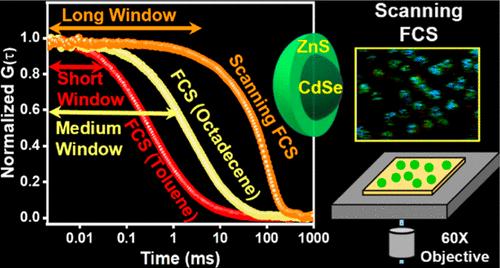当前位置:
X-MOL 学术
›
J. Phys. Chem. C
›
论文详情
Our official English website, www.x-mol.net, welcomes your
feedback! (Note: you will need to create a separate account there.)
Investigation of Carrier Dynamics in CdSe/ZnS Core–Shell Quantum Dots via Scanning Fluorescence Correlation Spectroscopy
The Journal of Physical Chemistry C ( IF 3.3 ) Pub Date : 2024-09-24 , DOI: 10.1021/acs.jpcc.4c04031 Asit Baran Mahato, Debopam Acharjee, Mrinal Kanti Panda, Dipak Samanta, Subhadip Ghosh
The Journal of Physical Chemistry C ( IF 3.3 ) Pub Date : 2024-09-24 , DOI: 10.1021/acs.jpcc.4c04031 Asit Baran Mahato, Debopam Acharjee, Mrinal Kanti Panda, Dipak Samanta, Subhadip Ghosh

|
Photoluminescence (PL) studies at the single-molecule level are widely used to realize carrier dynamics in nanocrystals, including quantum dots (QDs). Among the single-molecule-based PL techniques, single-particle PL intermittency or blinking studies on surface-immobilized fluorescent particles are very effective for probing slower processes (>10 ms). In contrast, fluorescence correlation spectroscopy (FCS) study in solution phase is used for studying faster processes (<1 ms). Although the recorded FCS curves involve a small ensemble of fluorescent particles, they can still reveal the distribution of a characteristic time constant and indicate sample heterogeneity. The combination of these two techniques, while providing an opportunity to study blinking dynamics of QDs across different time scales, leaves a milliseconds (ms) gap, resulting in an incomplete analysis of blinking. This study employs scanning fluorescence correlation spectroscopy (sFCS) to tackle this issue. This technique enables the tracking of blinking dynamics across a wide range of time scales without a gap, from microseconds to several hundred ms. We performed a comparative analysis between the results of sFCS conducted on surface-immobilized QDs and FCS conducted in the solution phase. This comparison revealed similarities in a qualitative sense but also highlighted significant quantitative differences, particularly in the blinking time scales. These discrepancies stemmed from the different sizes of temporal windows available for blinking study in these two techniques. Interestingly, the characteristic blinking time constant (τR) of our CdSe/ZnS core–shell QDs did not converge even in an extended window of a few hundred ms provided by sFCS. This behavior may be attributed to the power-law statistics of PL intermittency of QDs, where one key consequence is that blinking occurs across all time scales.
中文翻译:

通过扫描荧光相关光谱研究 CdSe/ZnS 核壳量子点中的载流子动力学
单分子水平的光致发光 (PL) 研究广泛用于实现纳米晶体中的载流子动力学,包括量子点 (QD)。在基于单分子的 PL 技术中,单粒子 PL 间歇性或表面固定化荧光颗粒的闪烁研究对于探测较慢的过程 (>10 ms) 非常有效。相比之下,溶液相中的荧光相关光谱 (FCS) 研究用于研究更快的过程 (<1 ms)。尽管记录的 FCS 曲线涉及一小群荧光颗粒,但它们仍然可以揭示特征时间常数的分布并指示样品异质性。这两种技术的结合,虽然为研究 QD 在不同时间尺度上的眨眼动力学提供了机会,但留下了毫秒 (ms) 的差距,导致对眨眼的分析不完整。本研究采用扫描荧光相关光谱 (sFCS) 来解决这个问题。该技术能够在从微秒到几百毫秒的广泛时间尺度上无间隙地跟踪闪烁动态。我们对表面固定的 QD 进行的 sFCS 结果与在解决阶段进行的 FCS 结果进行了比较分析。这种比较揭示了定性意义上的相似性,但也突出了显着的定量差异,尤其是在闪烁的时间尺度上。这些差异源于这两种技术中可用于眨眼研究的颞窗大小不同。有趣的是,我们的 CdSe/ZnS 核壳 QD 的特征闪烁时间常数 (τR) 即使在 sFCS 提供的几百毫秒的扩展窗口中也没有收敛。 这种行为可能归因于 QD 的 PL 间歇性的幂律统计,其中一个关键后果是闪烁在所有时间尺度上都发生。
更新日期:2024-09-24
中文翻译:

通过扫描荧光相关光谱研究 CdSe/ZnS 核壳量子点中的载流子动力学
单分子水平的光致发光 (PL) 研究广泛用于实现纳米晶体中的载流子动力学,包括量子点 (QD)。在基于单分子的 PL 技术中,单粒子 PL 间歇性或表面固定化荧光颗粒的闪烁研究对于探测较慢的过程 (>10 ms) 非常有效。相比之下,溶液相中的荧光相关光谱 (FCS) 研究用于研究更快的过程 (<1 ms)。尽管记录的 FCS 曲线涉及一小群荧光颗粒,但它们仍然可以揭示特征时间常数的分布并指示样品异质性。这两种技术的结合,虽然为研究 QD 在不同时间尺度上的眨眼动力学提供了机会,但留下了毫秒 (ms) 的差距,导致对眨眼的分析不完整。本研究采用扫描荧光相关光谱 (sFCS) 来解决这个问题。该技术能够在从微秒到几百毫秒的广泛时间尺度上无间隙地跟踪闪烁动态。我们对表面固定的 QD 进行的 sFCS 结果与在解决阶段进行的 FCS 结果进行了比较分析。这种比较揭示了定性意义上的相似性,但也突出了显着的定量差异,尤其是在闪烁的时间尺度上。这些差异源于这两种技术中可用于眨眼研究的颞窗大小不同。有趣的是,我们的 CdSe/ZnS 核壳 QD 的特征闪烁时间常数 (τR) 即使在 sFCS 提供的几百毫秒的扩展窗口中也没有收敛。 这种行为可能归因于 QD 的 PL 间歇性的幂律统计,其中一个关键后果是闪烁在所有时间尺度上都发生。













































 京公网安备 11010802027423号
京公网安备 11010802027423号